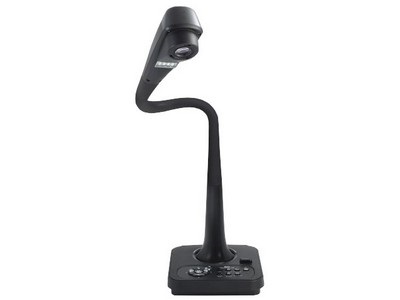How to choose a visualiser
A visualiser is a powerful downward-pointing digital camera that can be connected to a projector, allowing you to project detailed images of documents, pictures and objects. These images can then be converted into digital form and edited using appropriate software.

Frequently asked questions when choosing a visualiser
How do visualisers work?
When connected to a projector, a visualiser acts as the "eyes" - what the visualiser sees, the projector displays. They are usually placed on a desk, facing down, with the scanned object or document placed on a mat below. The image they record is then projected onto a screen or interactive whiteboard. Visualisers have a flexible arm that allows you to adjust the sensor head and the lens to the desired position.
Are visualisers appropriate for screening regular presentations?
Visualisers can capture not only information on 2D images, but also 3D objects. This means they add an extra visual level compared with regular projectors, making them an ideal tool for educational presentations.
What is the difference between optical and digital zoom?
Optical zoom allows you to actually zoom in on an image, whereas digital zoom merely enlarges a section of the image, causing a loss in image quality.
What other devices can you connect to a visualiser?
- To connect to a monitor or projector - HDMI or VGA
TIP: Before buying, check what types of connection are supported by your device. If the visualiser has no common connector, use a reduction cable..
What else should I consider when choosing a visualiser?


Shooting area
The shooting area expresses the size of the area that the visualiser can scan. It is given either in millimetres or as a paper size. A normal shooting area is around 400 × 300 mm or A3.

Frames per second
Expresses the number of frames per second that the visualiser can detect. The more frames per second, the smoother the projected image. The usual rate is around 30 frames per second.

Functions and features
Internal memory - allows you to store images on the device.
Zoom - allows you to resize the image without moving the visualiser.

Connectivity
Before buying a visualiser, consider how you will connect the device.
VGA (D-Sub) - for transmitting analogue video signals.
HDMI - for transmitting digital audio and video signals.
With the ability to connect to a network to play content stored on a local network or the Internet.
RJ45 (LAN) - cable connection for videos, presentations, and other content available on the net.
WiFi - wireless connection for playing multimedia via a network.
Glossary - Projectors
Keystone correction
Keystone correction is a function that corrects the output image if a projector is not placed perpendicular to the horizontal centreline of the screen (too high or too low).
FOV
FOV (Field of view) is the angle formed between your view and the projected image. The closer you are to the image and the longer the diagonal, the greater the angle, and vice versa.
PiP
Picture in Picture (PIP) means displaying two images (video or photo) from two different sources next to each other.
Glossary
Resolution and optimal viewing distance
Native resolution is based on the basic resolution of the image element (DMD chips for DLP projectors, LCD panels for LCD projectors). However, besides the basic resolution, projectors can display resolution lower or higher than native. In terms of quality, however, the picture will be worse, although this may not be visible to the human eye. The optimum viewing distance is derived from the native resolution; the closer you sit to the projector screen or wall, the higher the resolution should be. If the resolution is too low, the image quality will blur and pixelate.
Read about the difference between native and maximum projector resolution.